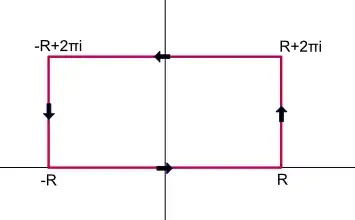First of all, I know this very integral has been asked many times on this site (e.g $\int_{-\infty}^\infty \frac{e^{ax}}{1+e^x}dx$ with residue calculus) and I don't have any problem calculating the residue here and the value of integral.
However I am struggeling in a part of this exercise, that is nowhere elaborated in good detail, namely to show that the two vertical lines $\to 0$ when $R \to \infty$ (see contour below) and in all the other threads it is only stated that it is clear that this happens, nowhere could I find a more detailed calculation.
Let $c_1(t)$ be the right vertical line (from $R \to R+2\pi i$) I have chosen the following parameterization: $c_1(t)=(1-t)R+(R+2\pi i)t = R +2\pi i t$, $t \in [0,1]$
$c_1'(t) = 2\pi i$ Let $c_3(t)$ be the left vertical line (from $-R+2\pi i \to -R$)
I have chosen the following parameterization:
$c_3(t)=(-R+2 \pi i)(1-t) + (-R)t=-R+2 \pi i(1-t)$, $t \in [0,1]$
$c_3'(t) = -2\pi i$
so for the right vertical line:
|$\int_0^1 \dfrac{e^{a(R+2\pi it)}}{1+e^{R+2\pi it}} 2\pi i dt | \leq 2\pi e^{aR} \int_{0}^{1} |\dfrac{e^{{(2 \pi i)}^{at}}}{1+e^Re^{(2\pi i)^t}}dt| \leq 2\pi e^{aR} \int_{0}^{1} \dfrac{1}{1+e^R} dt = 2\pi \dfrac{e^{aR}}{1+e^{R}}$ (are the steps here justified/correct?)
so for $R \to \infty$ clearly $2\pi \dfrac{e^{aR}}{1+e^{R}} \to 0$ because a < 1 (with l'Hôpital)
for the left vertical line: $|\int_{0}^{1} \dfrac{e^{a(-R)}e^{(2 \pi i)^{a}}e^{(2 \pi i)^{-t}}}{1+e^{-R}e^{2\pi i}e^{({2\pi i})^{-t}}} (-2\pi i) dt | \leq 2\pi\int_{0}^{1} |\dfrac{e^{a(-R)}e^{(2 \pi i)^{a}}e^{(2 \pi i)^{-t}}}{1+e^{-R}e^{2\pi i}e^{({2\pi i})^{-t}}}dt|=2 \pi \int_{0}^{1} \dfrac{e^{a(-R)}}{1+e^{-R}}dt$
are the steps until the last equality sign correct?
so I would need to calculate $\lim_{R \to \infty} \dfrac{e^{a(-R)}}{1+e^{-R}}$, but how to evaluate this and show that this will also be zero? I can not use l'Hôpital anymore. what would be the best way here?
